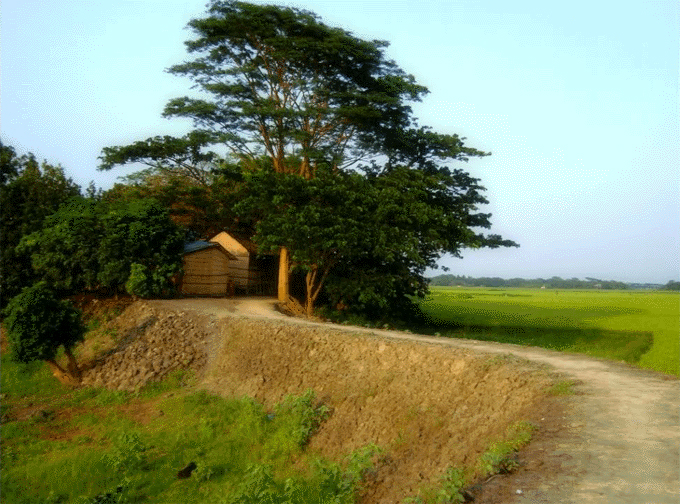
|
|
|
|
BY: SUN STAFF

The Fields of Bikrampur (Vikramapura) Jul 31, 2014 — CANADA (SUN) — A serial presentation of the holy places mentioned in the Jaiva Dharma of Srila Bhaktivinoda Thakur - Part 164.
Next on Jaiva Dharma's 'Glossary of Places' is Vikramapura, about which Srila Bhaktivinoda writes:
"Vikramapura - a famous place in Bangladesh in the district of Dhaka. Living here were Canda Raya and Kedara Raya, who were among the twelve feudal princes governing Bengal during the Muslim regime. At first they were saktas (worshipers of Durga), but later they became disciples of Srila Narottama Thakura."
There is only one mention of Vikramapura in Jaiva Dharma, and that is at the start of chapter ten. At this point in the story, Srila Bhaktivinoda begins a lengthy story about the Durga worshippers and mayavadis present around Mayapur, and how disturbed they became when Lord Chaitanya came to re-establish pure Vaisnavaism in their midst.
"A doubt arose in the mind of Sri Harihara Bhattacarya, a teacher who lived in Agradvipa. He discussed it with some people, but his doubt would not go away. It troubled his mind more and more. One day, when he was in the village of Arkatila, he asked Sri Caturbhuja Nyayaratna, "O saintly Bhattacarya, please tell me: How old is the Vaisnava religion?" Harihara Bhattacarya is an initiated Vaisnava and he worships Lord Krsna in his home. Nyayaratna Mahasaya has pursued twenty years of laborious study. He was not interested in any religion. He did not like talking about religion. Only when Goddess Durga was worshipped would he show a slight religious sentiment. Harihara's question made him think, "this Harihara must be a supporter of Vaisnavism. He could get me in some trouble. It is best to keep trouble away." Thinking in this way, Nyayaratna Mahasaya said, "What kind of question is this today? You have read many books. You even read the Muktipada. Look, in the whole of nyaya-sastra there is no mention of the Vaisnava religion. Why do you annoy me with this question?
Harihara said, "O Bhattacarya Mahasaya, I come from a Vaisnava family and I am an initiated Vaisnava. I never had any doubts about the Vaisnava religion. You know Tarka-cudamani of Vikramapura. Wishing to uproot the Vaisnava religion, he preaches against it in many places in this country and others also. In this way he has earned a lot of money. In a gathering of mostly Durga-worshippers he said the Vaisnava religion is modern in its origins and has no substance or reality. He said only low-class people call themselves Vaisnavas and upper class people have no respect for the Vaisnava religion. When I heard this pandita's conclusion at first I was pained at heart, but then, as I thought it over, I could see that before Prabhu Caitanyadeva there was no Vaisnavism in Bengal. At that time almost everyone performed worship by chanting Durga-mantras. Some few of us worshipped by chanting Vaisnava mantras, but all of those Vaisnavas wanted in the end to attain impersonal liberation and become Brahman. All those Vaisnavas were pancopasakas. However, after Prabhu Caitanyadeva Vaisnavism assumed a new form. Now Vaisnavas cannot bear to hear the words 'mukti' and 'brahman'. What is their understanding of devotional service? I do not have the power to say. There is a saying "The followers of a one-eyed guru will be led astray". I see these Vaisnavas are like that."
Bikrampur was once an important political centre in ancient Bengal. The capital city of the Chandra, Barman and Sen Rulers from the early 10th to early 13th Centuries A.D., the name of this place -- Vikrampura or Bikrampur -- survived as a pargana during the Mughal period. Previously this place was known as Baikunthapur and Rajnagar. Today, the inhabitants of a vast tract of land in Munshiganj district still proudly identify themselves as being from Bikrampur. The area has many temple ruins, along with temples, mosques and shrines still worshipped by the locals. Images of both Lord Visnu and Durga are found here.
Vikrampura is close to the modern town of Munshiganj. To its north lies the Ichhamati River, on the banks of which is a very high parapet running east to west, parallel with the ancient course of that river. East of Vikrampura is the ancient Brahmaputra. Two wide moats to the south and west, said to have been there since ancient times, are known today as the Mirkadim Canal and the Makuhati Canal.
(Virampura, to be continued…)
| |